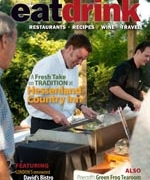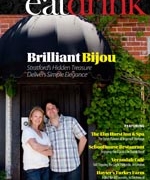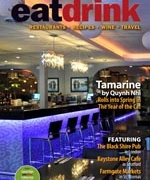Boob Tube Food
Watching celebrity chefs on the Food Network can be as addictive as eating your favourite foods. Television has brought the entertainment value of food from visceral to visual, even though it is quite paradoxical that an entire network serves up mouth-watering dishes that viewers will never eat. Although it may all be just a tease, Kathleen Collins tells us in her book Watching What We Eat that “people love to watch cooking, but it does not mean they love to cook or that they even do it at all.” Collins takes us on a tour of how cooking shows have become top notch entertainment, even though they started out as instructional programs for housewives, and she reveals how a combination of compelling chefs and scrumptious food presentation keeps us tuning in day after day. “The cable network gradually revamped the traditional instructional cooking program, adding live bands, participatory studio audiences, science, travel, and game shows, making the genre a microcosm of television and entertainment itself.”
Preceding any cooking on television, talk radio shows in the 1920s allowed a wider audience to share recipes on the air (just as the internet allows today). Betty Crocker and Aunt Sammy (both fictional) offered kitchen tips and dictated their favourite recipes on the air waves. This was expanded with educational cooking shows on television. “I doubt if there was ever a cooking school in the world that had as large an attendance as one cooking program seen on television.” A sign of the times in these early stages of the genre was blatant sponsorship – one show was called In the Kelvinator Kitchen chock full of Kelvinator appliances – indicating that advertisers were footing the bills.
Everyone these days knows Bobby Flay and Rachael Ray, but this book takes us back to 1946 when James Beard became the first professional chef to gain visual exposure on a show called I Love to Eat. In his autobiography, Beard wrote that he “finally had a chance to cook and act at the same time” but most people remember him as a chef with not a very fluid stage presence. Dione Lucas, one of Beard’s contemporaries and a Cordon Bleu-trained chef, also began airing cooking shows in 1947 with a style that was respectable and informative. “Watching Lucas might answer the question as to why people who don’t cook would ever watch a cooking show. Though she was a real woman undertaking real tasks, she was transformed by the magic of TV into a performer.” Cooking shows in the 1950s gained momentum with more candid and light-hearted shows to succeed as a viable source of entertainment. Chef Milani was one of the first in 1949 who had his whole family on the set as they laughed and joked around amid the on-air food preparation. Shows that followed were Deadline for Dinner and Cook’s Corner that were actually hosted by actors, rather than chefs, to add to the fact that personality and engagement with the audience were as important as the food being presented.
Julia Child came along in 1962 with her show The French Chef, shifting focus from homemaking shows to chef-inspired food. “Much of the food prepared on the show was not for the homemaker but for people interested in what chefs do in restaurants, revealing a budding social trend.” Graham Kerr became The Galloping Gourmet in the 1970s, spreading the gospel of cooking to a wider audience than Julia Child, making recipes more assessable to the common cook rather than the trained professional; although, like Jeff Smith as The Frugal Gourmet in the 1980s, Kerr was often criticized for not being a true chef and Collins writes: “There is an expectation, perhaps, that if someone is teaching us to cook, they ought to be a master. Obviously, however, it has little bearing, if any, on the success or popularity of a cooking show.”
By the end of the 1980s, cooking shows transformed food into a spectator sport and turned people into “foodies” – defined as “a person who is very very very interested in food.” Wolfgang Puck popularized designer pizzas. Martha Stewart showed us her good things. Emeril Lagasse turned it up a notch. Even though Emeril’s first show, How to Boil Water, was not a big success, he seemed to thrive with an audience around him and Emeril Live became a hit, paving the way for the Food Network into having entertainment potential with studio audiences. Chefs with personalities were sought after and it is this combination of compelling chefs and scrumptious food presentation that keeps us tuning in for more day after day.
Watching What We Eat is a very entertaining book, not only giving us a laundry list of past and present celebrity chefs, but also an in-depth look at television’s influence on culture and family life. Since fancy food is not a normal part of an everyday family menu, a good portion of Food Network viewers may only watch to see culinary geniuses with razzle-dazzle knife skills, but television has changed our view of food, not only as food entertainment but educating us along the way with practical kitchen techniques, nutritional information, and try-at-home recipes.










